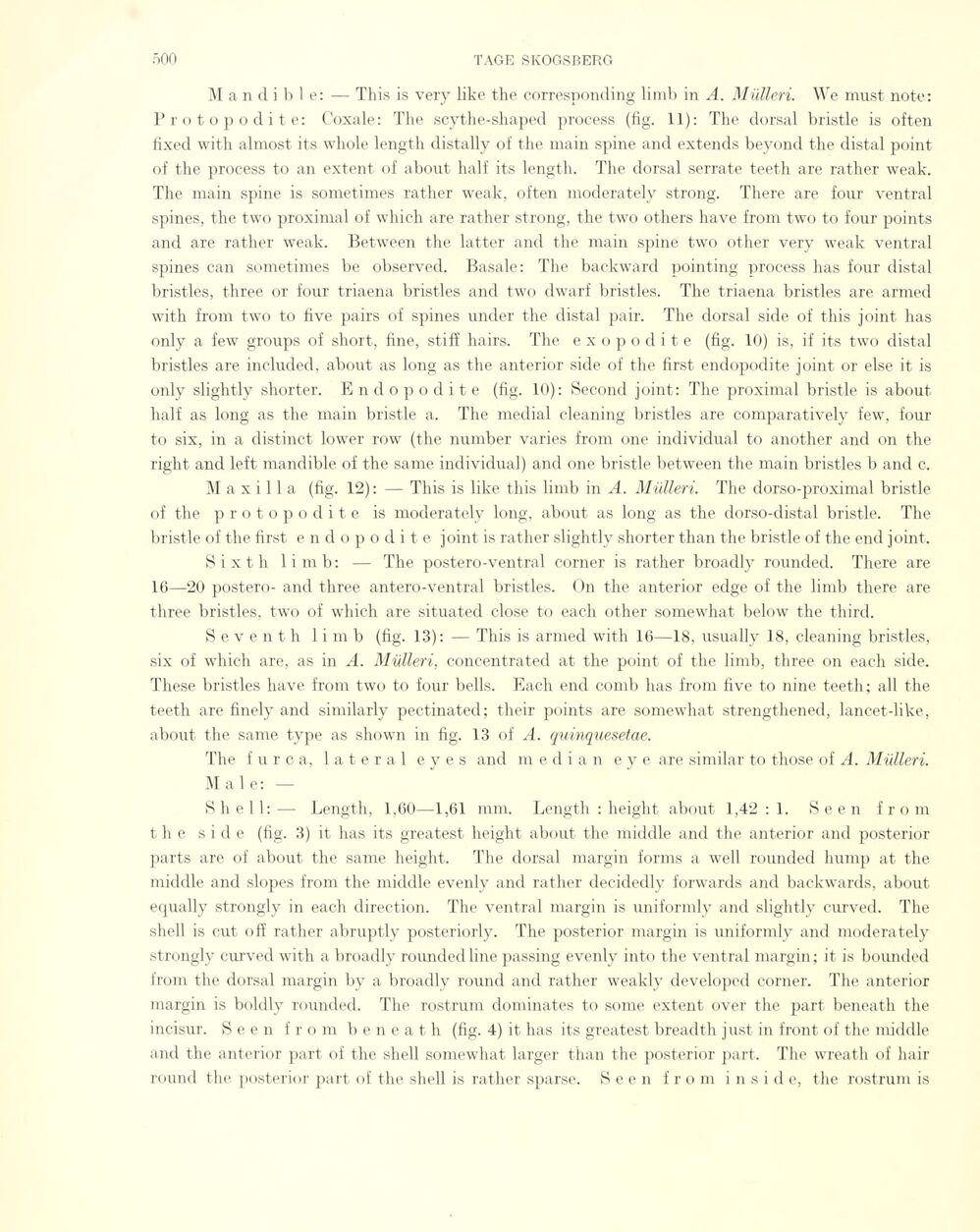
Full resolution (JPEG) - On this page / på denna sida - Sidor ...

<< prev. page << föreg. sida << >> nästa sida >> next page >>
Below is the raw OCR text
from the above scanned image.
Do you see an error? Proofread the page now!
Här nedan syns maskintolkade texten från faksimilbilden ovan.
Ser du något fel? Korrekturläs sidan nu!
This page has never been proofread. / Denna sida har aldrig korrekturlästs.
M a n d i b l e: — This is very like the corresponding limb in A. Müllen. We must note:
Pro topodite: Coxale: The scythe-shaped process (fig. 11): The dorsal bristle is often
fixed with almost its whole length distally of the main spine and extends beyond the distal point
of the process to an extent of about half its length. The dorsal serrate teeth are rather weak.
The main spine is sometimes rather weak, often moderately strong. There are four ventral
spines, the two proximal of which are rather strong, the two others have from two to four points
and are rather weak. Between the latter and the main spine two other very weak ventral
spines can sometimes be observed. Basale: The backward pointing process has four distal
bristles, three or four triaena bristles and two dwarf bristles. The triaena bristles are armed
with from two to five pairs of spines under the distal pair. The dorsal side of this joint has
only a few groups of short, fine, stifî hairs. The exopodite (fig. 10) is, if its two distal
bristles are included, about as long as the anterior side of the first endopodite joint or else it is
only slightly shorter. Endopodite (fig. 10): Second joint: The proximal bristle is about
half as long as the main bristle a. The medial cleaning bristles are comparatively few, four
to six, in a distinct lower row (the number varies from one individual to another and on the
right and left mandible of the same individual) and one bristle between the main bristles b and c.
Maxilla (fig. 12): — This is like this limb in A. Mülleri. The dorso-proximal bristle
of the protopodite is moderately long, about as long as the dorso-distal bristle. The
bristle of the first endopodite joint is rather slightly shorter than the bristle of the end joint.
S i X t h limb: — The postero-ventral corner is rather broadly rounded. There are
16—20 postero- and three antero-ventral bristles. On the anterior edge of the limb there are
three bristles, two of which are situated close to each other somewhat below the third.
S e v e n t h limb (fig. 13): — This is armed with 16—18, usually 18, cleaning bristles,
six of which are, as in A. Mülleri, concentrated at the point of the limb, three on each side.
These bristles have from two to four belis. Each end comb has from five to nine teeth; all the
teeth are finely and similarly pectinated; their points are somewhat strengthened, lancet-like,
about the same type as shown in fig. 13 of A. quinquesetae.
The furca, lateral eyes and median e y e are similar to those of A. Mülleri.
Male: —
Shell:— Length, 1,60—1,61 mm. Length : height about 1,42:1. Seen from
the side (fig. 3) it has its greatest height about the middle and the anterior and posterior
parts are of about the same height. The dorsal margin forms a well rounded hump at the
middle and slopes from the middle evenly and rather decidedly forwards and backwards, about
equally strongly in each direction. The ventral margin is uniformly and slightly curved. The
shell is cut oft’ rather abruptly posteriorly. The posterior margin is uniformly and moderately
strongly curved with a broadly rounded line passing evenly into the ventral margin; it is bounded
from the dorsal margin by a broadly round and rather weakly developed corner. The anterior
margin is boldly rounded. The rostrum dominâtes to some extent over the part beneath the
incisur. Seen from beneath (fig. 4) it has its greatest breadth j ust in front of the middle
and the anterior part of the shell somewhat larger than the posterior part. The wreatli of hair
round the posterior part of the shell is rather sparse. Seen from inside, the rostrum is
<< prev. page << föreg. sida << >> nästa sida >> next page >>